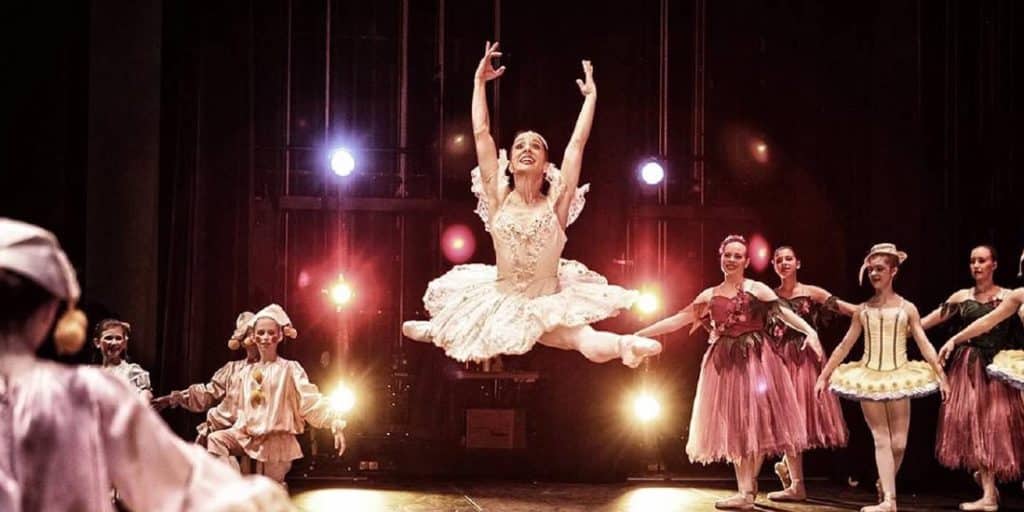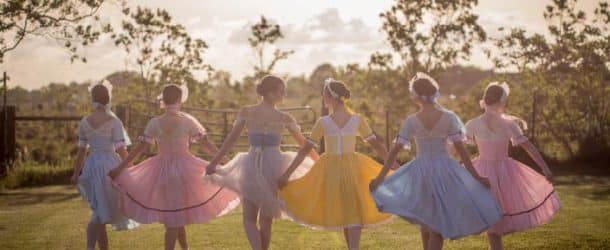For Local Colleen Benoit, Teaching WasA Cornerstone Of A Career In Ballet
By Brad Goins
Born and raised in Lake Charles, Colleen Benoit got her introduction to ballet dancing at the tender age of 4. A physical complication had forced her left foot to turn inward in its growth. The doctor put the foot in a brace and recommended that the young patient take up ballet.
Just as many Lake Area youths of the time, Benoit took up her ballet practice with local ballet teacher Ida Winter Clarke. Clarke’s well-respected ballet school, the Clarke Ballet Center, was located in a number of small cottages clustered together on 18th Street. “It’s incredible the things that happened in that small space,” says Benoit.
They were incredible enough that at the age of 12, Benoit auditioned for, and won, an opportunity to study with the School of American Ballet, then holding classes in New Orleans.
The School of American Ballet was the school for the New York City Ballet. During its southern sojourn, such mythic figures as Mikhail Baryshnikov and Rudolf Nureyev walked the halls. As a 12-year-old, Benoit wasn’t in a position to meet either dancer; but she does recall that Baryshnikov once winked at her — an event she considered quite a feather in her cap.
Also on hand was Benoit’s favorite ballet dancer, Merrill Ashley. A persistent Benoit eventually obtained a grudgingly given autograph from her idol.
It was, Benoit remembers, the “golden age of ballet” in America “because Russian dancers were defecting to the U.S.”
There was a Russian connection with Clarke as well. A few years earlier, in 1963, Clarke had travelled to New York City, where she was invited to watch choreographer George Balanchine, who was born in St. Petersburg, Russia, run dancers through his choreography for Tchaikovsky’s The Nutcracker. She was told she could take notes about all she saw. In three subsequent performances of the ballet by Clarke’s Lake Charles Ballet Society, Balanchine’s moves were seen on the stage in Lake Charles.
It was Benoit’s experience in the American School of Ballet that made her “more serious” about seeking a career as a ballet dancer.
Benoit chose her early favorites in ballet as a result of “what the Lake Charles Ballet Society exposed me to.” Benoit says she would “never have been able to develop [her ballet] loves” without the experiences she had as a student of Clarke. As a youth, the LCBS enabled her to perform the lead in such ballet masterworks as The Nutcracker and Coppelia, the great comic ballet of Léo Delibes.
A Dancer Becomes A Teacher
As she approached college age, says Benoit, she “wanted to figure out a way to keep dancing at a high level and get a college degree.” One has to pick one option or the other as a rule.
Benoit approached her studies at McNeese State University by asking herself: “What would benefit me as a ballet teacher?” After a great deal of thought, she decided instruction in education was the answer.
During her MSU studies, Benoit eventually became a master teacher, lead teacher and a literacy intervention teacher by means of the U.S. government’s Striving Readers Comprehensive Literacy Program.
Although it might seem an odd career move for a ballet dancer, Benoit wound up teaching at Nelson Elementary. She’d hold the same post during a 25-year career with the Calcasieu Parish School system — a tenure that ended only when she started her dance school — the Lake Charles Dance Academy — in 2011.
As for teaching elementary school, she says, “I loved that. I loved teaching kids. It was a sacrifice” to give up her elementary classes for ballet instruction: a sacrifice she overcame only when she experienced the satisfaction that came “by teaching my passion. I was very, very fortunate” (to be able to teach in the ballet school).
A Professional Standard
“It’s important for the girls (in the school) and my dancers to see my passion,” says Benoit.
But it’s not all about passion. It’s also about professionalism.
“These are young girls. They are impressionable … [I tell them], ‘Appreciate the fact you’re being treated like a professional. Be so proud.’”

Benoit feels she’s recreating the aura of professionalism she experienced at Clarke’s school. “We had master classes from famous people. We had the San Francisco Ballet [practicing there]; the entire Houston Ballet. That’s what we were used to. That was the norm.”
These days, Benoit’s school is full — just short of overcrowded — on full-length (9 am-3 pm) days of ballet teaching on Saturdays and slightly shorter days on Sundays. “It’s a positive environment … It’s just happy. I have to tone down the fun.”
The combination of youth and commitment with passion, professionalism and positivity yields productivity and accomplishment. “They’re quick to learn. I’m so, so amazed at the level we’re dancing at now.”
Even though the school’s dancers have performed such challenging works as Stravinsky’s Firebird (staged in tandem with the Dallas Ballet), Benoit doesn’t burden young students with ballets that are overly controversial or complex. “I’m very conservative — both because of the age of the dancers and my upbringing,” she says. She notes in particular the influence of Clarke, who taught the young Benoit with a similarly conservative approach.
Several of the teachers in Benoit’s school also studied with Clarke at one time. “They have full-time jobs,” says Benoit. Nevertheless, they find the time to participate in the teaching sessions. “They want to be a part.”
Who Goes To See Ballet?
Those who grew up in America in the 1950s and 1960s saw ballet on a regular basis. Popular movies such as Oklahoma, Seven Brides for Seven Brothers and West Side Story were nothing other than ballets put on film. The Ed Sullivan Show routinely featured famous troupes performing ballets in whole or in part. And every night, a selection of variety shows on television featured dancers who’d been trained for ballet and sometimes mimicked the ballet in the popular programs.
In 2017, says Benoit, ballets tends to be supported by ballet dancers or former dancers and their families. But she says she sees “a new population of young people who would rather see a local production than something from out of town.” In preference of canned entertainment, they’re willing to give local ballet a shot.
A work such as La Fille Mal-Gardée, which Benoit’s dancers will perform Nov. 17-18 at the Rosa Hart Theater, may be the ideal work to gently introduce such an audience to ballet. The work, says Benoit, is “light.” It doesn’t make the cerebral demands of a Stravinsky or Prokofiev epic. Instead, sophisticated ballet is enlivened by such jovial features as a maypole dance and a miniature pony. The overall look will be easy on the eyes, with some sets made by local artisan Randy Partin and others rented from the New Orleans Ballet.
Benoit’s 17-year-old daughter Cecilia will dance the lead, while the male lead will be danced by visiting artist Ramon Gaitan, who has danced for the Richmond Ballet, the Ballet Grandiva and many famous choreographers.
Even though Cecilia is only 17, she’s already spent two summers working at the Boston Ballet. Before that, she studied with the Houston Ballet and other major troupes.
On Nov. 17-18, these dancers will perform as the Lake Charles Ballet Theatre. Benoit is the artistic director of the company. She sees the company as carrying on the legacy of Clarke’s Ballet Society.
All Things French
Benoit and the troupe are emphasizing “all things French” this season. The idea of a French-themed year came from Cissy Clarke, Ida’s daughter, who “continues to help” Benoit.
The French theme gives the season continuity. (Works to come include a ballet based on paintings of Edgar Degas and George Gershwin’s An American In Paris.)
But continuity isn’t the only concern. Benoit emphasizes that “it’s important to highlight … the French culture in Louisiana. It’s dying.”
Spare Time
Earning a living in the arts is a tough proposition for almost everyone. Benoit credits much of her success in this venture to her “supportive” husband John. An operator at Lyondell Basell, John is quite content to pursue his interest in outdoor sports while Colleen spends her time in the arts.
Although John is more of a football fan than a ballet fan, Colleen says he does like to see the ballets performed. This is especially the case with the New York City ballet and its famed “leotard ballet,” which eschews elaborate sets and costumes in favor of highlighting the dancers’ bodies with bright light.
Colleen says that John has come to appreciate the amount of work that goes into making a ballet.
As for spare time, Colleen spends hers looking for films or recordings of ballets or documentaries about ballet and dancers. Two recent discoveries are Restless Creature, which concerns dancer Wendy Whalen, and The Dance Goodbye, on Benoit’s favorite Merrill Ashley. Each of these two dancers retired after 30-year careers with the New York City Ballet. Each faced serious challenges with her physical condition and her artistic identity after retirement.
One could say that Benoit’s life has not strayed far from ballet — were it not for the years she put in teaching elementary children. As it turns out, it was almost as if she had two careers: those of dancing ballet and teaching young people. And fortunately for all, there was a good deal of overlap in the careers.
To learn more about the Lake Charles Dance Academy, The Lake Charles Ballet Theatre or the upcoming performance of La Fille Mal Gardée, call 477-1510. The Dance Academy and the Ballet Theatre both have pages on Facebook.

















Comments are closed.